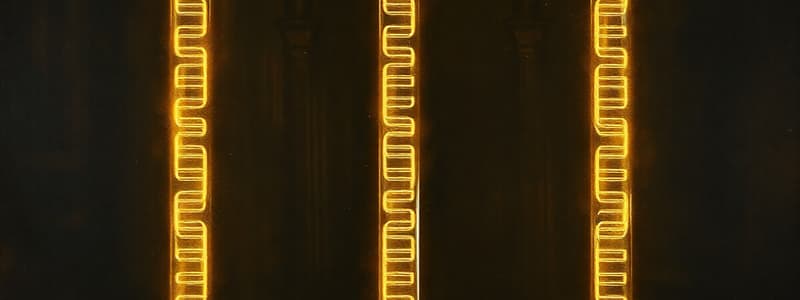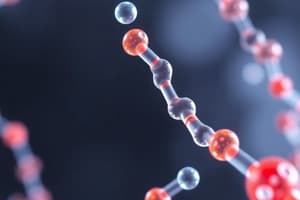Podcast
Questions and Answers
What do restriction endonucleases specifically recognize to make cuts in DNA?
What do restriction endonucleases specifically recognize to make cuts in DNA?
- Specific nucleotide sequences called restriction sites (correct)
- Long repetitive sequences
- Chromosomal centromeres
- Transcription factors binding sites
What is the main purpose of using calcium chloride in the chemical competence method?
What is the main purpose of using calcium chloride in the chemical competence method?
- To enhance DNA replication
- To promote cell division
- To increase membrane permeability for DNA uptake (correct)
- To stabilize the cell wall
Which step in molecular cloning involves the introduction of the recombinant vector into a host cell?
Which step in molecular cloning involves the introduction of the recombinant vector into a host cell?
- Insertion into a vector
- Isolation of DNA of interest
- Selection of recombinant cells
- Transformation into a host cell (correct)
In blue-white screening, what color do colonies appear if they have successfully taken up recombinant plasmids?
In blue-white screening, what color do colonies appear if they have successfully taken up recombinant plasmids?
What is the result of a bacterial cell undergoing a heat shock during transformation?
What is the result of a bacterial cell undergoing a heat shock during transformation?
What type of DNA cut do restriction endonucleases create when both DNA strands are cut at the same point?
What type of DNA cut do restriction endonucleases create when both DNA strands are cut at the same point?
Which method would most directly create temporary pores for DNA to enter a cell?
Which method would most directly create temporary pores for DNA to enter a cell?
During the selection of recombinant cells, what is typically used to identify successfully transformed bacteria?
During the selection of recombinant cells, what is typically used to identify successfully transformed bacteria?
How does natural competence differ from chemical competence in terms of DNA uptake?
How does natural competence differ from chemical competence in terms of DNA uptake?
What is formed when the DNA of interest is successfully ligated into a cloning vector?
What is formed when the DNA of interest is successfully ligated into a cloning vector?
Study Notes
Restriction Endonucleases
- Cut DNA at specific nucleotide sequences called restriction sites
- Recognize palindromic sequences
- Create either blunt or sticky ends used in genetic engineering to splice DNA fragments
Competence
- Ability of a cell to take up extracellular DNA from its environment during transformation
- Natural competence: Some bacteria naturally take up DNA under certain conditions (e.g., Streptococcus)
- Chemical competence: Cells treated with calcium chloride to increase membrane permeability
- Electroporation: Electric field applied to create temporary pores in the cell membrane, allowing DNA to enter
- Heat shock: Cells exposed to a sudden increase in temperature, creating membrane pores for DNA uptake
Molecular Cloning Steps
- Isolation of DNA of interest: Gene is cut using restriction enzymes
- Insertion into a vector: Isolated DNA is ligated (joined) into a cloning vector (e.g., plasmid)
- Transformation into a host cell: Recombinant vector is introduced into a competent host cell, usually bacteria
- Selection of recombinant cells: Cells that have successfully taken up the recombinant DNA are selected using antibiotic resistance or reporter genes
Blue-White Screening
- Differentiates between bacterial colonies containing recombinant plasmids and those that do not
- Bacteria with non-recombinant plasmids produce a blue color (due to β-galactosidase activity)
- Bacteria with recombinant plasmids (insertion of foreign DNA disrupts the lacZ gene) produce white colonies, indicating successful cloning
Studying That Suits You
Use AI to generate personalized quizzes and flashcards to suit your learning preferences.
Description
Test your knowledge on restriction endonucleases, the competence of cells, and the essential steps involved in molecular cloning. This quiz covers key concepts such as DNA cutting, transformation techniques, and the use of vectors in genetic engineering. Perfect for students of genetics and biochemistry!



